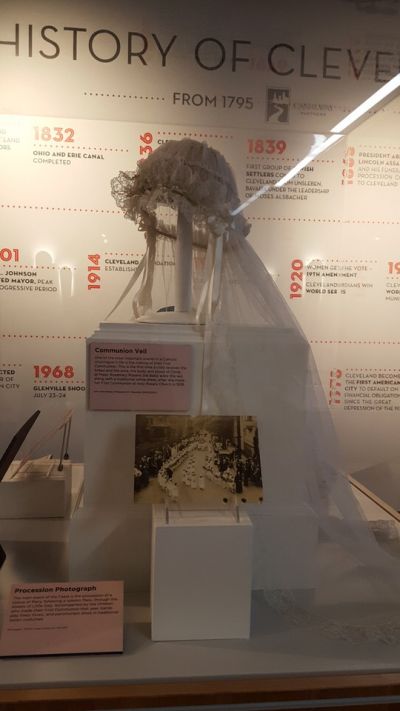Among the most important rites celebrated by Catholics is the First Communion. This is when a child usually around the age of 7 or 8 accepts the body and blood of Christ symbolized in the Eucharist for the first time. Special attire is required for the sacred ceremony. Girls normally wear white dresses with a veil. The white symbolizes purity and connects them to their Baptism, when they also wore white.
The veils and dresses are often kept as remembrances of the special day and are sometimes passed on to the next generation. Rosemary Rosaria Del Balso Colarochio made her First Communion at Holy Rosary Church in Cleveland’s Little Italy in 1938. She stored away her veil and in 2015, it made its way to the Western Reserve Historical Society’s Italian American Collection. Rosemary’s daughter, Paulette, explains why she decided to donate such a treasured heirloom to WRHS:
“My family and I came across Mom's communion veil when cleaning her home after she passed. Even though it had yellowed over the last 75 years, it was still an ‘awww moment’ for us. Then, we had to decide what to do with it. We also came across her First Holy Communion picture, which I knew was already in the WRHS Italian American Collection. I thought WRHS might like an artifact to enhance the picture. After discussion with other family members, we decided to donate it with the hopes that it would be preserved and shared with others.”
This past August, staff at WRHS were developing new displays for the Community History section of the exhibit Cleveland Starts Here® sponsored by the Jack, Joseph and Morton Mandel Foundation. Holy Rosary Church was selected to be highlighted in one of the displays and Rosemary’s veil was the perfect artifact to help tell the story of the church and its parishioners. Paulette was honored and pleased when she learned the veil would be on display. When she finally got to visit the exhibit last month and saw the veil in the case with Rosemary’s name on the label, it brought tears to her eyes. Paulette describes her experience:
“The lighting and stand used by the curators at WRHS made the veil appear to have taken center stage in the display case. The veil certainly looked better than when we made the donation! It looked whiter, the lace was more pronounced and the tiny flowers and ribbons on the side were clearly evident. I knew that we had made the right choice in donating Mom's veil to the Italian American Collection at WRHS. Her veil wasn't stuck in an attic or drawer anymore. Family, as well as museum visitors now and for generations to come, would be able to see and appreciate the veil and its details.”
Displays in the Community History section rotate on a regular basis, so Rosemary’s veil has been taken down and is back in storage for preservation. But other artifacts both meaningful to families and the general community, just like the veil, will be put on display because sharing the history of the people and communities of Northeast Ohio is an important part of the mission of WRHS. The next display will be focused on holiday traditions in Cleveland.



